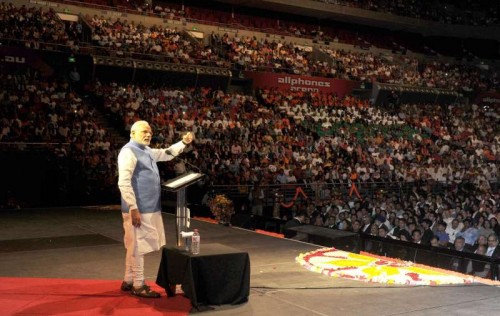
By Ranjana Narayan
For those following Prime Minister Narendra Modi’s addresses abroad, his switch to English instead of the expected Hindi during his recent foreign visits may have come as a surprise. But, for a politician known to be a powerful orator and effective communicator, the reason was simple – he wished to convey the essence of his speech in his own way.
And the teleprompter has been a useful aid in his switchover to English.
For Modi, who has comfortably addressed six rousing election speeches in a day, speaking extempore in Hindi comes effortlessly, though he is a native Gujarati speaker, who avoided speaking in English unless absolutely required.
Initially all his diplomatic interactions were in Hindi with a translator at hand. His speeches during his Japan and US visits were in Hindi, with the translators scrambling to keep pace.
But Modi, known for his use of pithy yet simple words, is understood to have been dissatisfied with the translated versions. Reason: they failed to convey the essence of his speeches, several conversations IANS has had with aides revealed.
Modi first chose to speak in English during the PSLV launch in July at the Indian Space Research Organisation (ISRO). Aided by a teleprompter, Modi switched to English interspersed with some Hindi sentences. Again in September, Modi spoke in English in his congratulatory address to ISRO scientists when India’s Mangalyaan was successfully placed in the Mars orbit.
Both times, the switch to English was perhaps keeping in mind that many scientists, including the top ones, are from non-Hindi speaking states.
But with regard to foreign policy, it was believed that the Modi government would keep Hindi as its medium of communication, in keeping with how other government heads, including those from China, Russia, or non-English speaking European states, do.
Modi’s first speech in English, without the teleprompter, was during the BRICS – Brazil, Russia, India, China, South Africa – summit in Fortaleza, Brazil, in July, when he read out his speech in English.
During his US visit, Modi delivered his UN address in Hindi. In Washington, during the bilateral interaction with President Barack Obama, an avid user of the teleprompter, and in his address to the Council on Foreign Relations, the prime minister stuck to Hindi. He gave a short speech in English at the Central Park in New York, aided by a teleprompter.
But he took to English in a big way during the Australia and Fiji visits and in Nepal for the SAARC Summit.
In Australia, Modi spoke in English with the aid of teleprompters at a cultural event hosted by the mayor of Brisbane on Nov 16. He followed it up by speaking in English the next morning during a power breakfast in Brisbane with top business leaders from Australia’s Queensland state and India.
In his address to the Australian parliament in English, Modi even cracked a local joke on “shirtfronting”, evoking laughter.
Modi, who uses his hands expressively during his speeches and likes to pause to await the audience reaction whenever he has posed a query or made a light hearted remark, is able to get directly across to his foreign audiences with his English speeches.
The two teleprompters are placed on either side of the podium and not visible to TV audiences. Modi swings his head comfortably between the two, reading the lines as they scroll down in keeping with the speed of his speech-delivery.
In his informal interactions during the G20 Summit in Brisbane, Modi was seen cracking jokes and chatting and laughing with global leaders, including Obama, mostly without the help of aides, highlighting how comfortable Modi has become in conversing in English and also in conducting diplomacy.
Obama is known to be a frequent user of the teleprompter, even for short speeches. During an event last year, Obama jokingly chided his aides for forgetting to load his speech on to the teleprompter, which they did hurriedly.